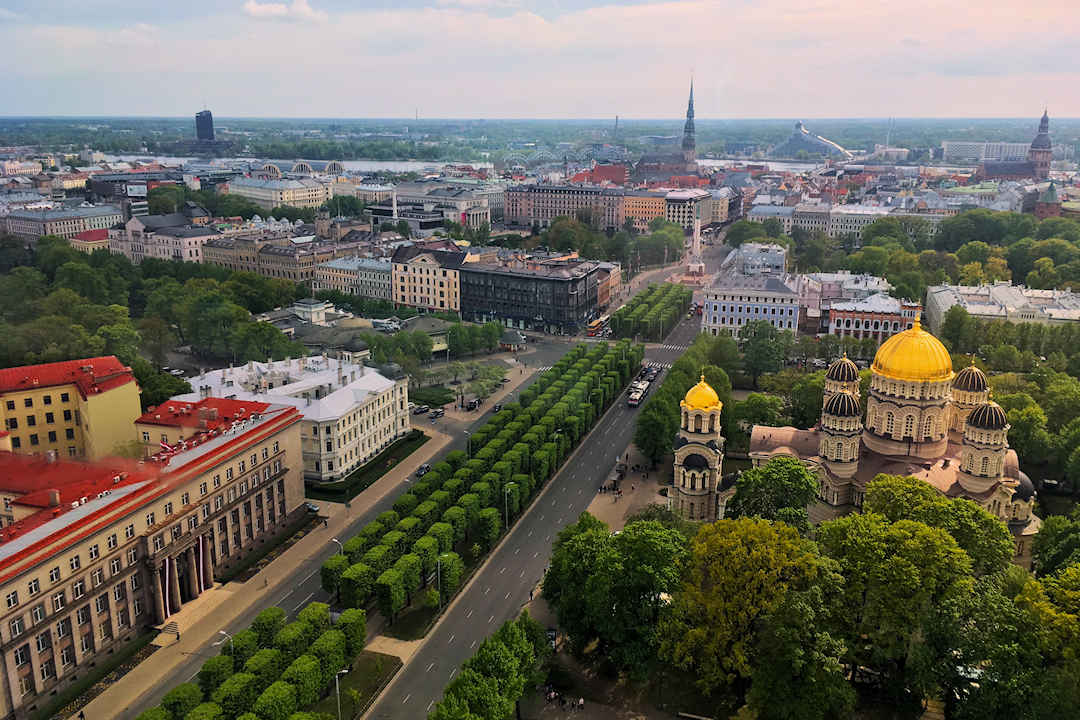This article may contain links to products and services we use and recommend. We may receive compensation when you click on links to those products. For more information, see our Disclosure Policy.
Are you planning to visit Latvia and wonder what there is to see and do (in a week)? Whether you can only spare a week to visit Latvia or have three weeks to explore Lithuania and Estonia, we’ve got THE itinerary for you – showing you a bit of everything: historic cities, National Parks and the Baltic Sea.
Latvia is one of three small countries sandwiched between the Baltic Sea and almighty Russia. It was the last of the Baltic states to regain its independence after Soviet occupation on 21 August 1991. Approximately 20% of Latvia is protected (and 56% of the country is forested) – hence our recommendation to experience Latvia’s great outdoors.

A true symbol of resilience: Unveiled in 1935 during Latvia's first stint of independence, the Freedom Monument survived 40+ years of Soviet occupation
Three reasons why you should visit Latvia
- Not only is the historic centre of Latvia’s capital, Riga, a UNESCO World Heritage site, but with more than 800 Art Nouveau buildings, Riga (not Barcelona) is also considered the Art Nouveau capital of Europe.
- Only a short trip outside Riga, grand wooden seaside homes and ancient Teutonic castles await exploration.
- Latvia has four outstanding national parks (two of which are featured in our itinerary). Sounds wonderful? Well, it is.
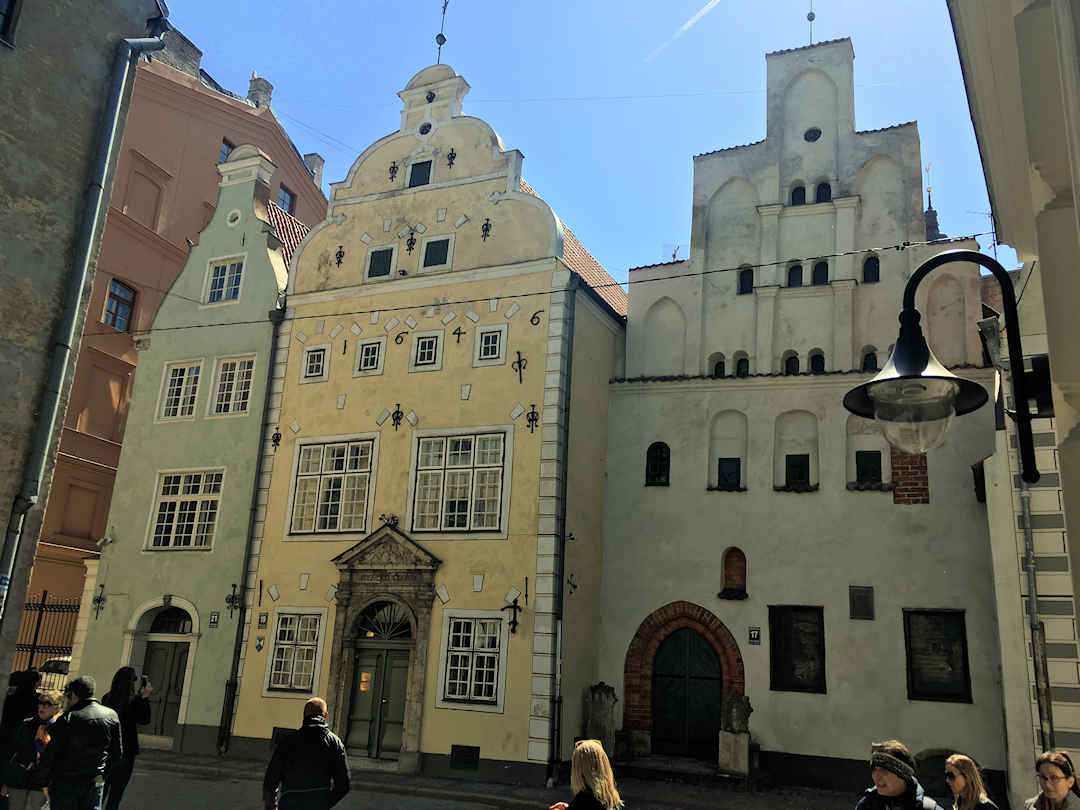
Dating from the 15th to the 17th centuries, the Three Brothers are the oldest complex of dwelling houses in Riga
Map of Accommodation, Points of Interest, Eateries and Transport
Below is a map of the recommended accommodations, points of interest, eateries, and transport terminals or stops mentioned in this article.
| Destination | Suggested Stays (Night) |
|---|---|
| Riga | 3 nights |
| Jūrmala | Day trip only |
| Ķemeri National Park | Day trip only |
| Sigulda | 2 nights |
| Cēsis | 2 nights |
Our itinerary assumes you travel to Riga overland from Lithuania (or arrive in Riga by plane). If you don’t have time to continue your travels to Estonia, your closest airport to return home is Riga (88 kilometres / approximately 2.5 hours southwest of Cēsis).
To organise your mode of transport between the three stops (and for your day trip from Riga), check out the transport section in our Baltics article.
But first, let’s talk about what there is to see and do…
Highlights of Riga (and surrounds)
Day 1 – Riga
As with Lithuania‘s capital Vilnius and Estonia‘s capital Tallinn, we recommend starting your first day in Riga with a free walking tour around the Old Town. Several benefits of doing this include:
- Cost-effective: No upfront fees, tips are optional.
- Local Insights: Guides offer insider knowledge about the area.
- Flexible Schedule: Tours run frequently, easy to fit in.
- Meet Travelers: Great way to connect with fellow tourists.
We did the Old Riga Free Tour and throughly enjoyed it.
For lunch, head to Salve in the Old Town, to one of the Lido Bistro outlets or Riga’s Central Market in the old Zeppelin hangars opposite the bus station where you arrived. That market alone would be a reason for us to move to Riga.
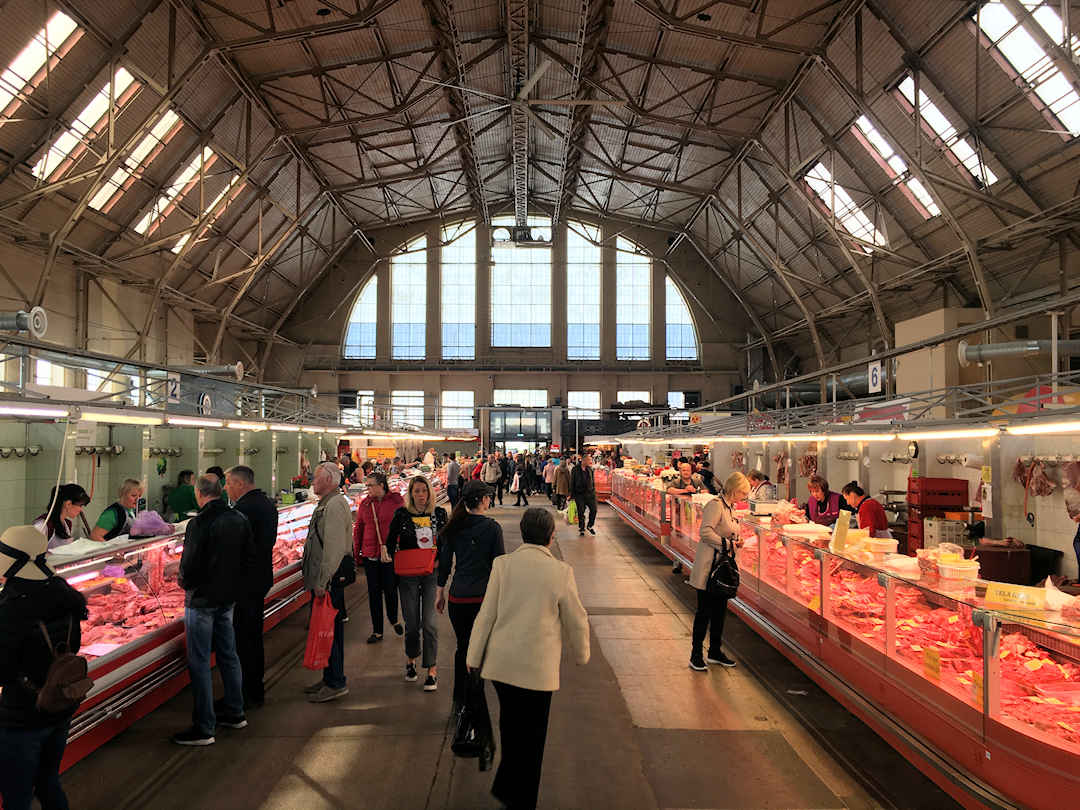
If we lived in Riga the Central Market would be our favourite hangout
If you enjoyed the Old Town walking tour and have a soft spot for architecture, Riga Free Tours now offers a walking tour of Riga’s Art Nouveau treasures.
If you’re more into art than architecture, you may want to check out the Latvian National Museum of Art.
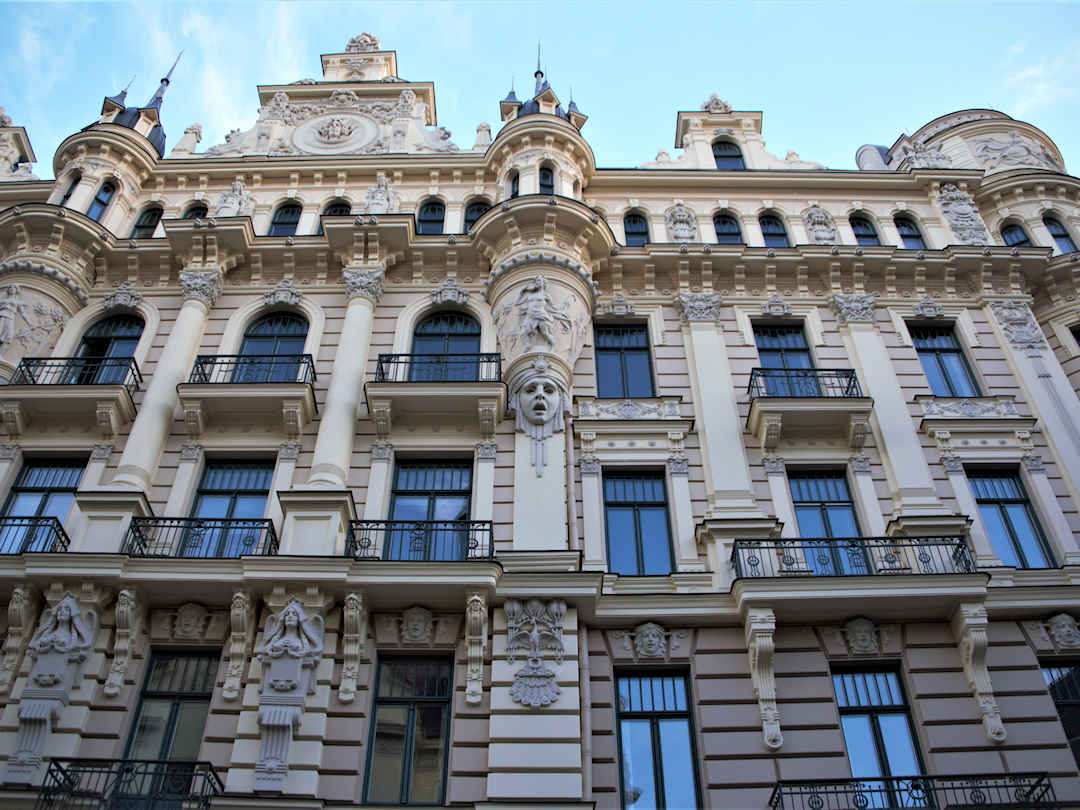
And if you’re more into history (especially if you’ve missed the Museum in Vilnius), you may want to join the guided tours
- at the Museum of Latvia’s Occupation (Raiņa Bulvāris 7) or
- at The Corner House (Brīvības Iela 61) – the former KGB building houses an exhibition about the KGB operations in Latvia.
For more details, check out the museum’s website.
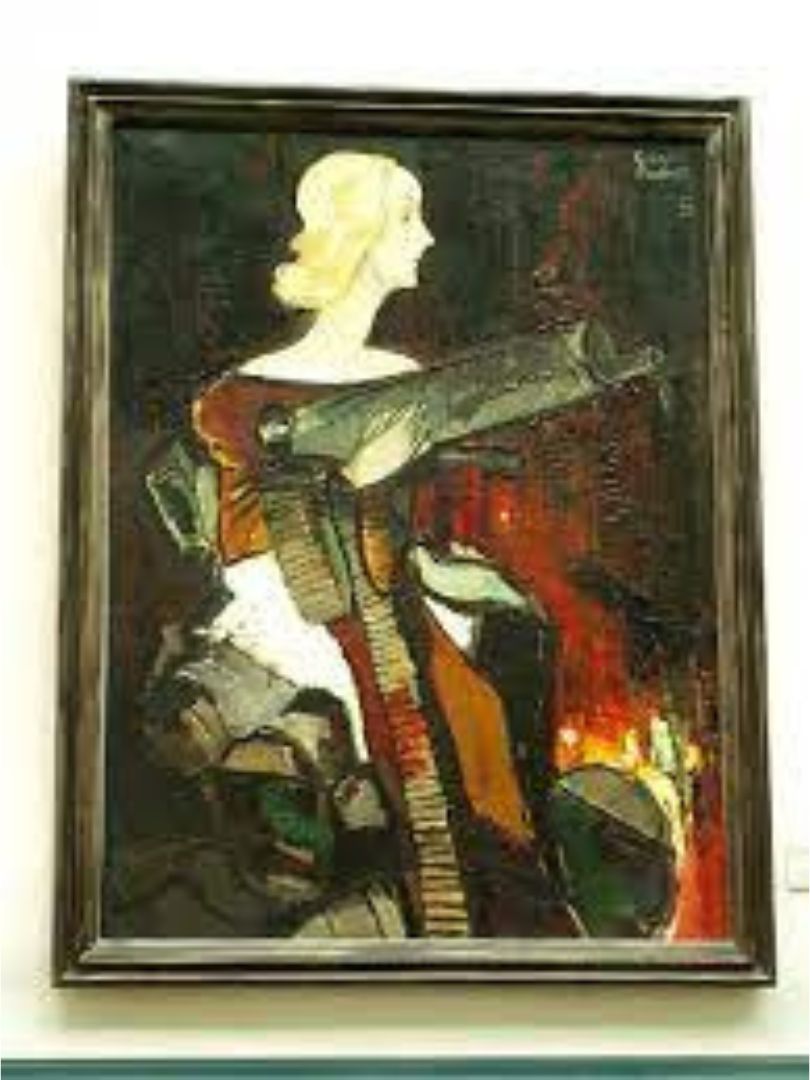
If you love art visiting the Latvian National Museum of Art is a MUST | Madonna with machine gun - Painting by Kārlis Padegs
Finish your first day with innovative cocktails, delicious modern Korean food, and sunset views of Riga from the Skyline Bar at the Riga Radisson Blu Hotel. Or if you’re in town on a Friday, head to Riga’s Cathedral to join the weekly organ concert at 1900h.
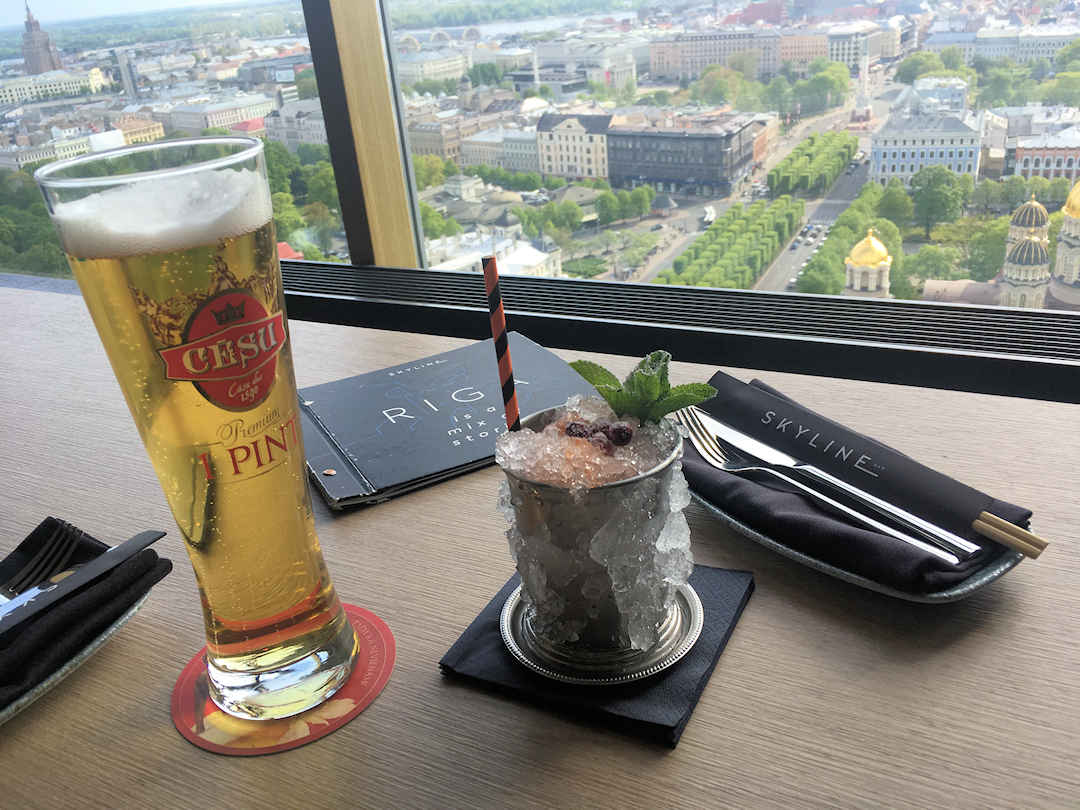
Sunset views of Riga that don't cost you a cent (unless you complement them with a cocktail and a bite to eat)
How much does it cost to explore the Baltics?
Visiting the Baltic countries costs us an average of EUR45.17/USD50.54 per person daily. Check out our country costs here:
Day 2 – Jūrmala and Ķemeri National Park
On your second day in Riga, we suggest you head out of the city. All the below destinations can be reached by public transport. Alternatively, you can hire a car for the day.
How to find the best deals on rental cars
Most of the time, we use public transport to get us around. But occasionally, hiring a car or scooter just makes it easier or gets us to places we couldn't go without a set of wheels. Whenever we do hire a vehicle, our first point of call are local rental providers. A quick Google Maps search shows who's near us. We then check the reviews and only contact those other travellers had good experiences with.
If we can't find anyone we're comfortable with, we search for deals on aggregator websites. We've used Rentalcars.com and DiscoverCars.com in the past and had only good experiences with them. Both partner with trusted brands like Hertz, Avis, Budget or Europcar (and in some locations even local providers) - so you can compare car hire options in a similar way you'd compare accommodation offers across Agoda and Booking.com.
First up, head to the historic seaside resort of Jūrmala, 40 kilometres / approximately 30 minutes west of Riga. The main sights are in the suburb of Majori, so if you take the minibus or train, alight there.
If you drive and visit between 01 April and 30 September, you must buy an entry pass (EUR2 per vehicle). Ticket machines are at the town entrance and in Majori itself. In turn, all municipal parking lots are free of charge. The quaint seaside town is easy to explore on foot.
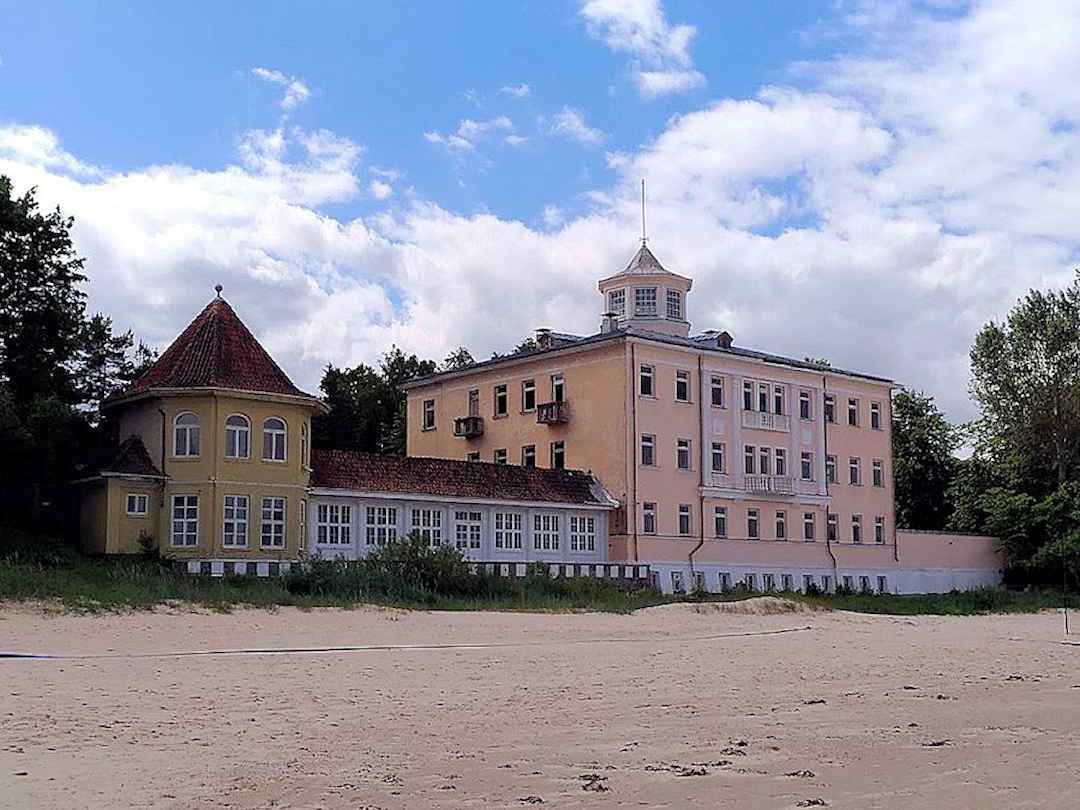
For a taste of the Baltic Sea near Riga, head to Jūrmala
Your next stop is the Ķemeri National Park (11 kilometres/20 minutes by car or 30 minutes by bus/train). The Park offers many flat trails and boardwalks. Before you go, check out the park map online or visit the Tourist Information Centre opposite the train station in Majori. Also, make sure you bring insect repellent.
If you didn’t hire a car, take the minibus or train to the township of Kemeri. If the distances don’t bother you, you can walk all trails from the train station/bus stop. Alternatively, you can hire bicycles in Kemeri (right at the station – the shop is called Velo Noma) or in Majori – including electric bikes (for example, at ABC Grupa or ZLX). Be aware, though: The ride from Majori to Kemeri, while flat, is just over 20 kilometres one-way (or 40 kilometres return).
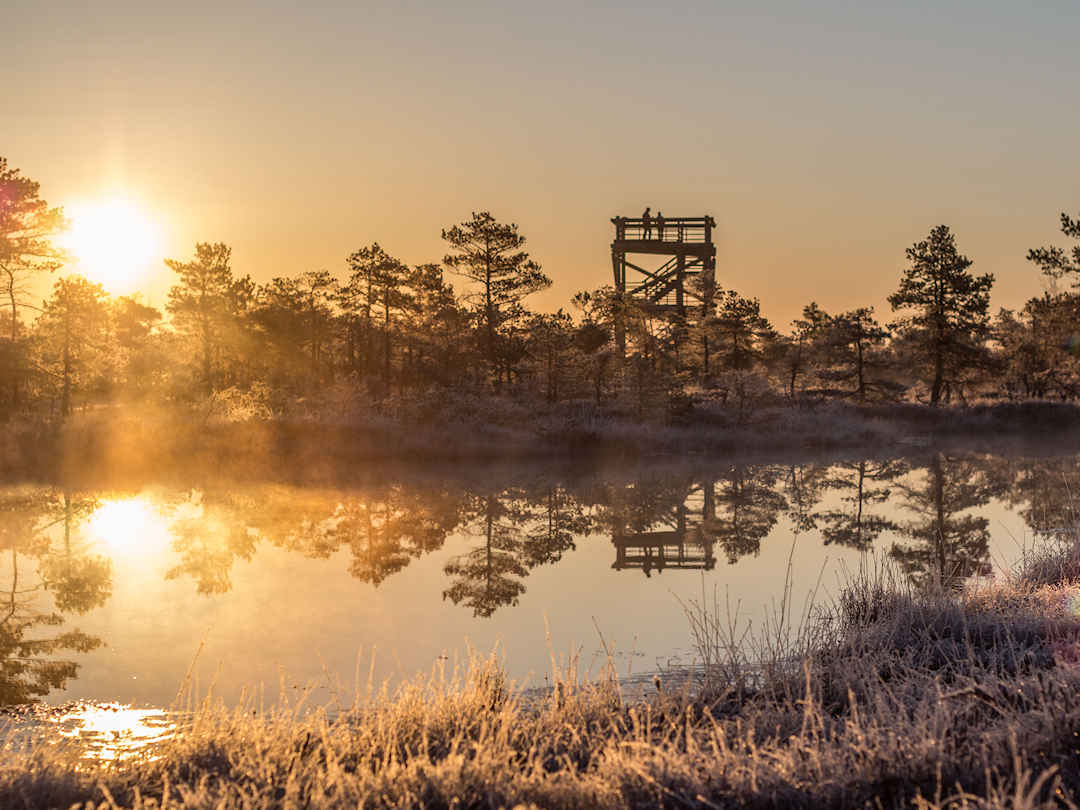
Kemeri National Park is only an hour by car/bus/train outside of Riga | Image courtesy of Artis VEIGURS
As for trails, our recommendations are
- Great Ķemeri Bog Boardwalk: The larger boardwalk loop is about 3.5 kilometres from the parking lot (or 11 kilometres return from Kemeri train station)
- Lake Sloka Path: From the car park at Lake Sloka, the circular route is approximately three kilometres. If you are walking or cycling, it is approximately five kilometres from Kemeri train station to the parking lot at Lake Sloka (or ten kilometres return).
If you have time for a little detour after finishing the Lake Sloka Path you can add the Black Alder Swamp Boardwalk, which starts at Meža Māja, approximately three kilometres from Kemeri train station (or alight at the bus stop Meža Māja). If you walk the Lake Sloka Path, you pass Meža Māja anyway. The loop itself is less than one kilometre long.
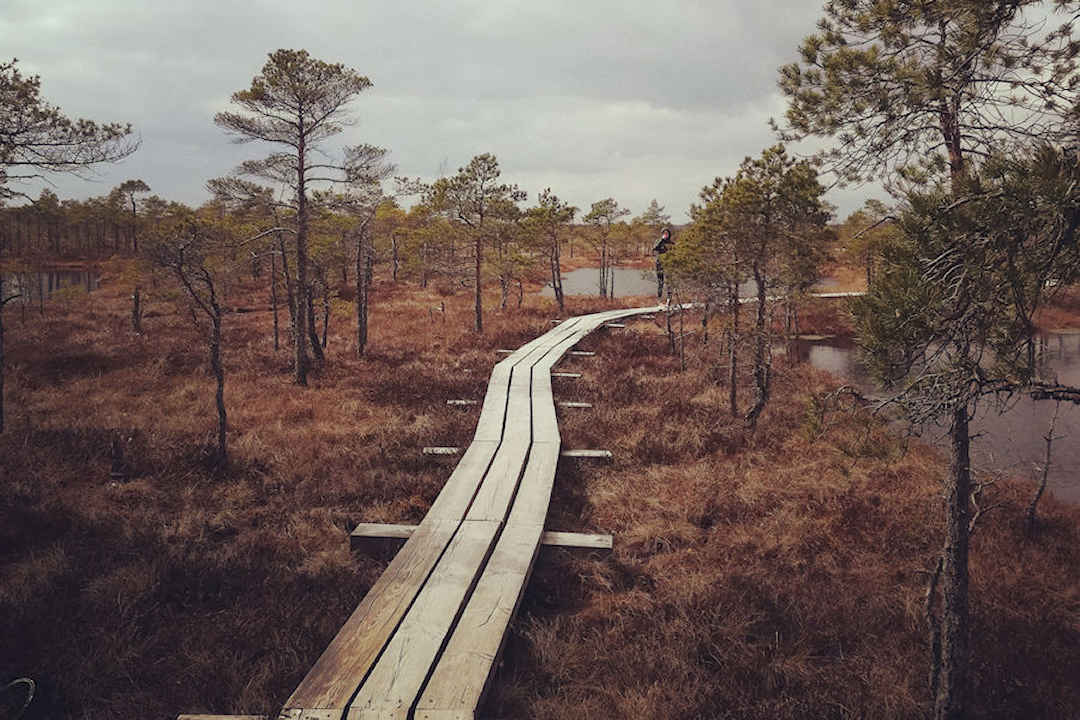
The Great Ķemeri Bog Boardwalk was first recommend to us by a Riga barista | Courtesy of Antonija RIMAC
Food and Drinks in Latvia
- Head to one of the Lido Bistros in Riga to try Latvian cuisine at reasonable prices. For traditional dishes in a more refined environment, check out Salve in Riga’s Old Town.
- For delicious modern Korean dishes and sunset views over Riga, visit the Skyline Bar at the Radisson Blu Hotel.
- While staying in the historic Hotel Sigulda might be a bit too expensive, the restaurant serves delicious food made from fresh local produce.

Crispy Fried Rice is one of the amazing dishes available at the Skyline Bar | Photo courtesy of Riga Radisson Blu
Highlights of Gauja National Park
The Gauja National Park is just over an hour by train or bus east of Riga. While you could visit Sigulda or Cēsis (the two main vantage points for the park) on a day trip from Riga, we recommend you stay in either or both to experience the National Park and all it offers. You can hike, kayak or bike past colourful sandstone formations and enjoy beautiful vistas over the Gauja River valley.
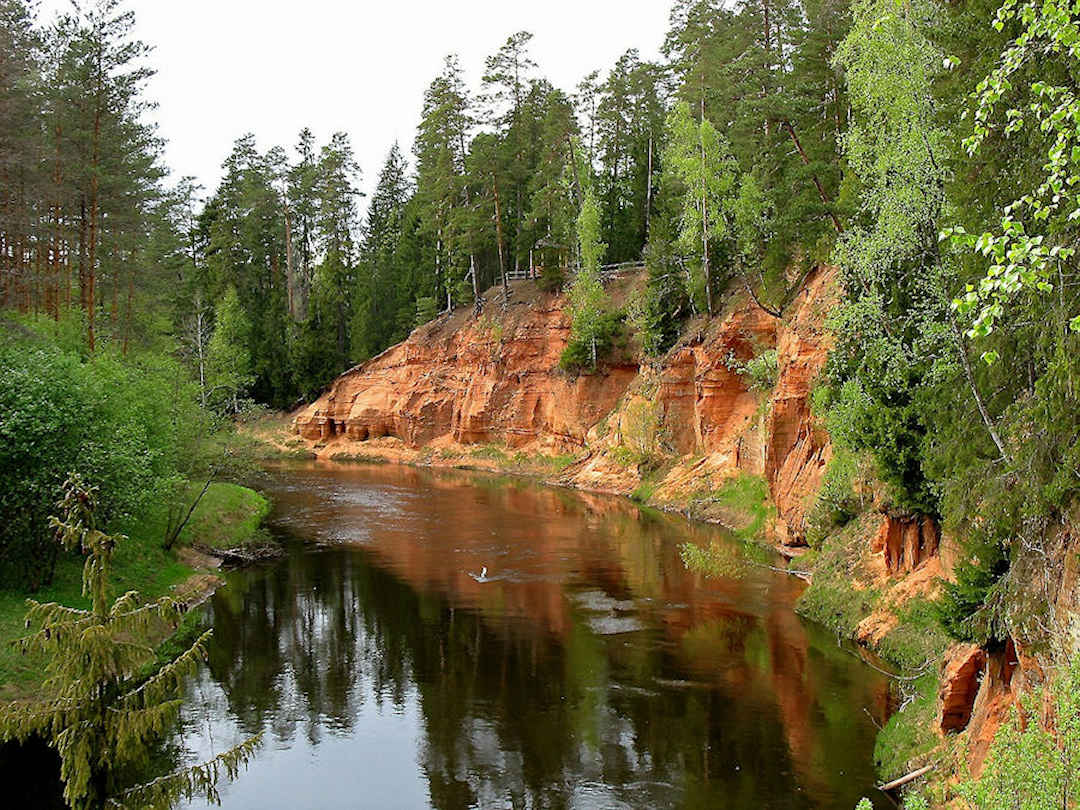
In Gauja National Park, you can hike, mountainbike or kayak past beautiful sandstone formations | Photo courtesy of Pixabay
You can hire bikes and boats in both Sigulda and Cēsis:
- Sigulda: There is a bike rental shop opposite the train station and an e-bike rental shop by the cable car station. Several companies also offer boat rentals.
- Bike rental in Cēsis is available near the Cēsis Castle and Museum entrance. Boat rental in Cēsis is offered by Žagarkalns, approximately 6 kilometres west of the township.
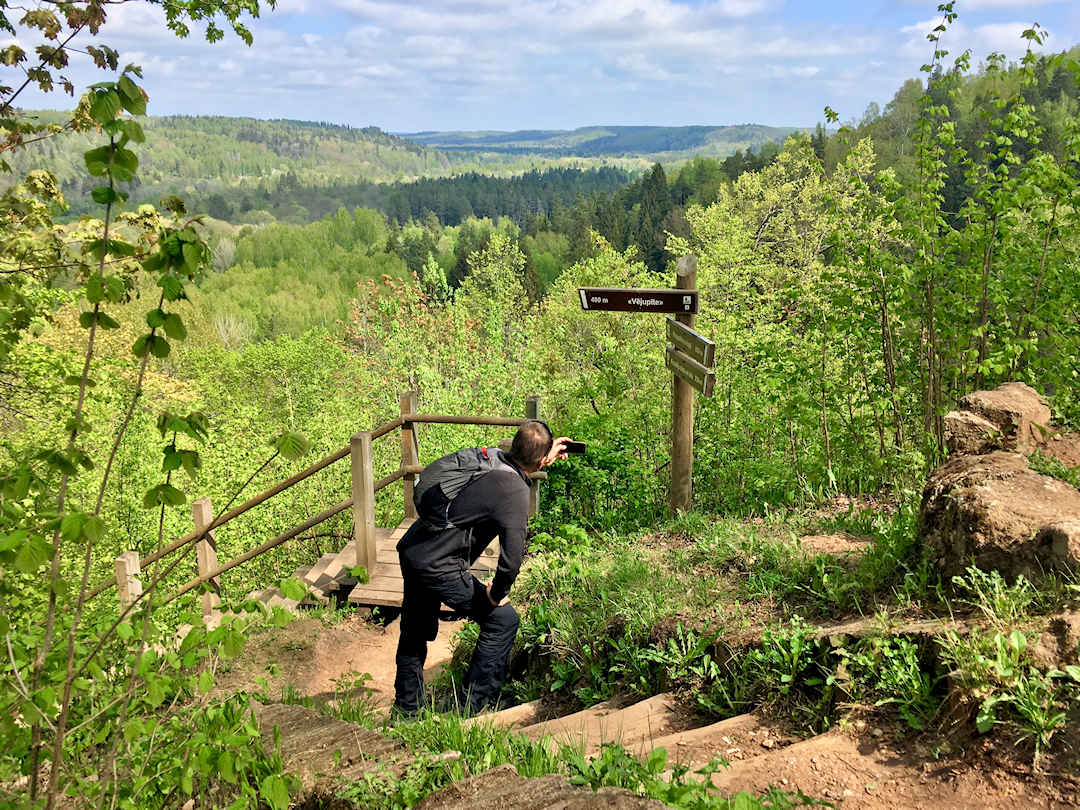
A hike in Latvia's first and largest National Park doesn't cost you a cent
The Gauja National Park offers many options for nature lovers. You can also bungee jump from the cable car across the Gauja River in Sigulda or zip line on the cable car’s cableway.
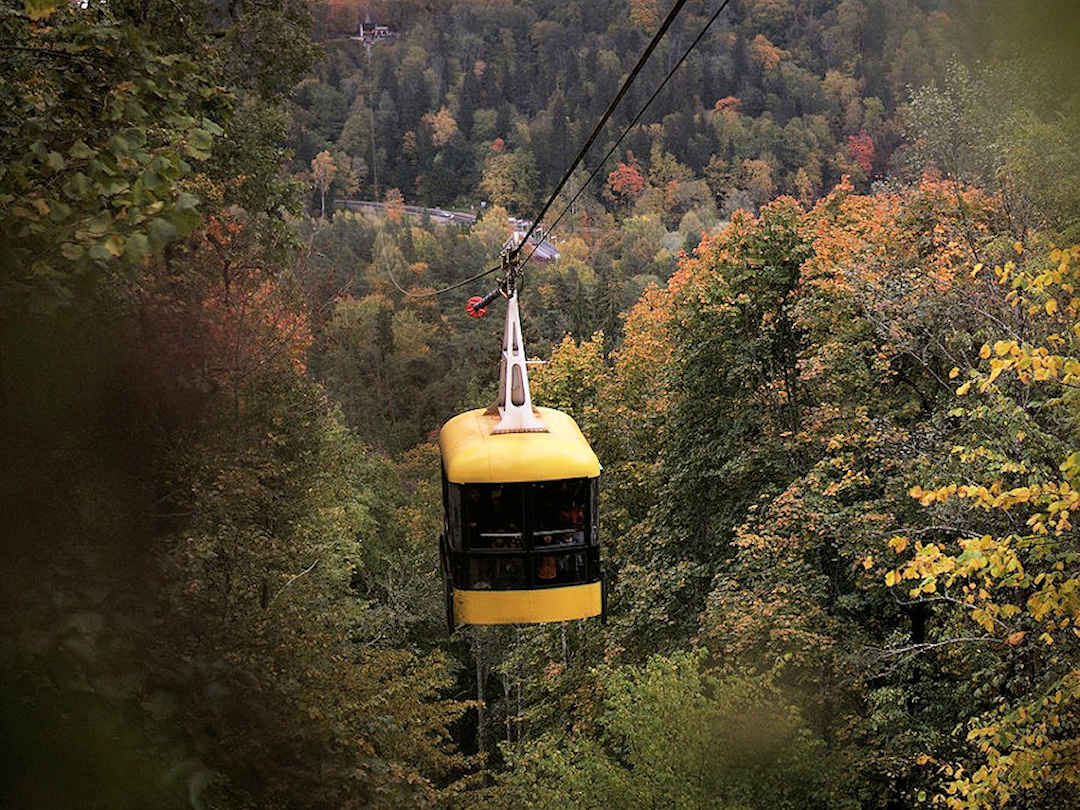
In Sigulda, you can not only take the cable car across the Gauja river but also bungee jump off the cable car and zipline across on the cable way | Photo by Reinis Kaspars on Pixabay
You can also visit the old castles of the Livonian Order (Teutonic Knights who settled in the area at the beginning of the 13th century). Our favourite was the Cēsis Castle and Museum:
- With the help of old-fashioned lanterns, you can explore the castle’s western tower by yourself.
- From May to September, workshops and a kitchen garden are staffed by locals dressed in medieval clothing. These people explain medieval crafts (for example, woodblock printing by the very passionate Viesturs Aboltins or straw hat making), traditional games, and armour.
- Finally, a sizeable and super interesting museum awaits in the Manor House, explaining the castle’s history of Cēsis and Latvia (make sure you use the leaflets provided in additional languages).
We spent several hours in the castle complex.

Cēsis Castle and Museum was our favourite historical site in the Gauja National Park
Before you go, if you liked our article and found it helpful, we would appreciate it if you could share it with your friends and family via the Share buttons below. Even better: Leave a short review on Trustpilot or Google, which would help us further build our online reputation as a (trustworthy and helpful) travel and lifestyle blog.

